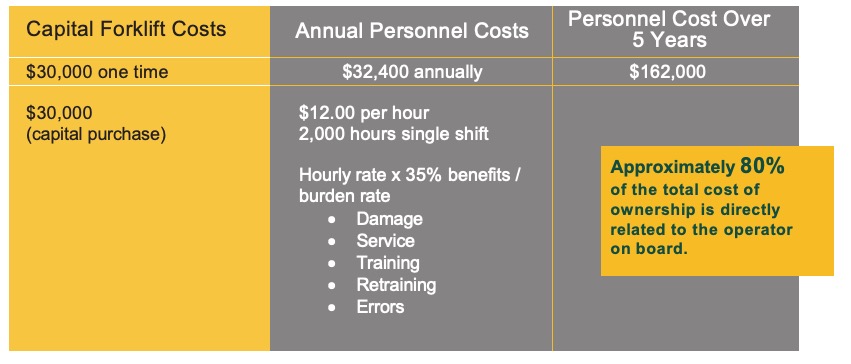The Advantages of AGVs
Automated guided vehicles (AGVs) provide a number of advantages for distribution centers and manufacturing facilities with predictable, repeatable processes.
What are the Advantages of AGVs?
Automation has worked its way into nearly every corner of our lives. Forward-looking companies have embraced automation and searched for increased opportunities to utilize it to reduce costs and increase efficiency. While automated guided vehicles (AGVs) have been used in some capacity for several decades, manufacturing centers and distribution facilities are beginning to realize that utilizing more AGVs can add up to a very positive ROI over the long term. Let's explore some of the benefits of AGVs.
Savings in Personnel Cost vs. AGV Cost
The price tag on an AGV might raise a few eyebrows if you’re trying to pitch the idea under the banner of savings, as you’re likely to spend $30,000 or more to buy a new automated guided vehicle. However, once you get past the initial AGV cost, the savings from reduced labor costs and personnel can add up quickly. The chart below shows the estimated cost savings of just one AGV over the course of five years, where the total cost of ownership for a standard forklift is around 80% related to the operator.

Another AGV benefit after your initial investment comes from the fact that AGVs don’t require increases in compensation. Particularly in a tight labor market it’s also important to realize that moving to AGVs means you won’t have to deal with wage increases, bonuses, insurance, 401k matches, etc.
On top of costs associated with salary and benefits, it’s especially important to account for the costs of human error. AGVs do not make the same mistakes a human does, which can lead to less damage to products and equipment. AGVs will not get tired or distracted, allowing for 24/7 operation in a wide range of conditions. Depending on your operation, removing a human operator from certain processes will also allow you the option of lowering heating and cooling costs as your AGV can function in a wider range of temperatures and conditions than a human.
Technology = Efficiency, Accuracy and Safety
The newest generations of AGV pallet stackers, like the Jungheinrich EKS 215a NA, utilize laser navigation which allows them to move with remarkable precision, an accuracy that’s within millimeters. That accuracy is vital when interfacing with conveyors. These stackers can monitor for obstacles by using enhanced sensors and reflectors, allowing them to integrate seamlessly and safely into environments that include manual trucks and pedestrians. With programmable top speeds, smooth and controlled movements, and collision detection systems, AGVs are designed with a high level of safety.
On top of the precision and safety features, AGVs can also be programmed to prioritize orders to maximize efficiency in order processing. These vehicles can be integrated easily into your existing processes including your Enterprise Resource Planning (ERP) software or Warehouse Management Software (WMS). Jungheinrich AGVs have been successfully integrated with over 100 different WMS, ranging from off the shelf to customer specific and can be tailor-made to fit your existing WMS. Have changes? No problem. The modular AGV system offers the flexibility for the vehicles to respond to changes. Don’t have a WMS? Jungheinrich AGVs can even operate as an autonomous standalone system without a host connection.
While you might think AGVs would only work in the most rigid of structures, the current state of these products allows far greater flexibility than you would imagine.
When Automation Makes Sense
Yes, AGVs are more flexible than they’ve ever been, but it’s important to do a thorough assessment of where, when, and how you should implement automation to maximize your ROI. AGVs are at their most valuable when utilized in processes that have predictable, repeatable movements. You can work with your local Jungheinrich dealer to identify the most valuable task for automation in your facility. Run through this list of common questions to help figure out your best application for AGVs:
- What is the load/unit?
- What is the volume or throughput of the product movement?
- What are the temperature conditions?
- How many shifts are you currently running?
- What is the labor content?
- What are the space requirements?
- What type of Warehouse Management Software do you have?
Have Questions About the Advantages and Disadvantages of AGVs?
Making an investment in AGVs is a big decision. If you’d like to talk through your processes and weigh the AGV benefits for your business versus the costs, contact us here.









